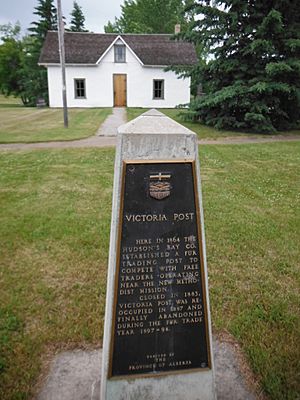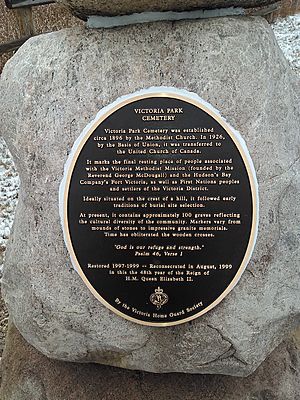Fort Victoria, Alberta facts for kids
 |
|
| Lua error in Module:Location_map at line 420: attempt to index field 'wikibase' (a nil value). | |
| Location | Smoky Lake, Alberta, Canada |
|---|---|
| Type | National Historic Site, Cultural landscape |
| Official name: Victoria District National Historic Site of Canada | |
| Designated: | 17 October 2001 |
Fort Victoria was a historic trading post built by the Hudson's Bay Company in 1864. It was located near what is now Smoky Lake, Alberta, right by the North Saskatchewan River. The fort was a place where people traded goods with the local Cree First Nations.
Before that, in 1862, it was a Methodist mission. This mission was built where Indigenous people often gathered. The entire area was named Victoria Settlement, in honor of Queen Victoria.
Today, this important historical site is a museum called Victoria Settlement. The small community nearby is known as Pakan, Alberta. You can also find the Metis Crossing Cultural Heritage Gathering Centre close by.
Contents
Where is Fort Victoria?
Fort Victoria (also known as Victoria Settlement) is on the north side of the North Saskatchewan River. It's about 100 kilometers (62 miles) downstream from where Edmonton House used to be.
The fort was a key stop along the Victoria Trail, which was part of the longer Carlton Trail. This trail connected Edmonton and Fort Pitt. It was a resting place for travelers moving by land or by river. While not as big as the trading post in Edmonton, Fort Victoria slowly grew into a small farming community. This often happened near Hudson's Bay Company posts in the early days.
Fort Victoria's History
The area where Fort Victoria was built was first settled by colonists as a missionary site in 1862-1863. It became the home of the McDougall missionary family. This spot was chosen because it was a popular gathering and hunting area for the Cree people. There were often 10 to 100 Cree tents there, according to the McDougalls.
People in the area used a traditional land system called the French riverlot system. This led to a mixed community of First Nations, Métis, and European settlers. Even today, for several miles around the museum, this old riverlot system is still used for farms. This shows that people were living and farming there before the official Dominion Land Survey of the 1880s. That survey usually created large, square plots of land.
Fort Victoria is a great example of a community that changed over time. It started by relying on hunting wild animals, especially bison, and trading furs. Later, it shifted towards farming, growing crops, and raising livestock.
In 1864, George Flett was given the job of opening the Hudson's Bay Company trading post at Fort Victoria. Flett had both Orkney and Cree heritage. He and John Norris led the very first group of Red River ox-carts from Winnipeg to Edmonton. This long journey took them three and a half months, and they passed through Victoria Settlement.
Flett was in charge of the post until 1866. He was responsible for building the fort and starting trade with the local Indigenous people. He quickly got a good supply of high-quality furs. Flett and his helpers would take these furs by horse and dog sled to Fort Edmonton. From there, they were sent downriver to Hudson's Bay.
The oldest building in Alberta that is still on its original foundation is the clerk's quarters at Fort Victoria. It was built in 1865.
The fort closed in 1883 but opened again in 1887. It continued to operate until 1897-1898.
Later, the fort's location became a central point for early settlers in eastern Central Alberta. It became known as the Victoria Settlement and then later as Pakan. This name came from the Cree chief Pakannuk, whose name was sometimes spelled "Peccan or Seenum."
Even later, the settlement served as a Methodist mission for Ukrainian Canadian settlers in the area.
The post was also a very important stop on the Carlton Trail, which connected Winnipeg to Edmonton. A part of this historic trail in eastern Edmonton is now a paved road called Victoria Trail. It's named in honor of the fort and the trail's long history as an Indigenous path and trade route.
Fort Victoria is part of the larger Victoria District and the Kalyna Country ecomuseum. It has been recognized as a national historic site of Canada, a provincial historic site of Alberta, and also by Smoky Lake County.
Victoria Park Cemetery
The Victoria Park Cemetery was started around 1896 by the Methodist church. It is located on a hill that looks over the river. This is the second of six cemeteries built in the settlement.
It has about 100 graves that you can still see. These graves belong to both Indigenous people and settlers. It's thought that some victims of an 1870 smallpox outbreak might be buried there. The cemetery was cleaned up and rededicated in 1999.
Victoria District National Historic Site
Fort Victoria and the Victoria Park Cemetery are located within the larger Victoria District. This district is one of twenty-three national historic sites in Alberta. Only three of these sites, including the Victoria District, are north of Edmonton. The Victoria District is also the only rural national historic site in Alberta.
Museum Connections
The museum at Fort Victoria is connected with several important organizations. These include the CMA, the CHIN, and the Virtual Museum of Canada.


